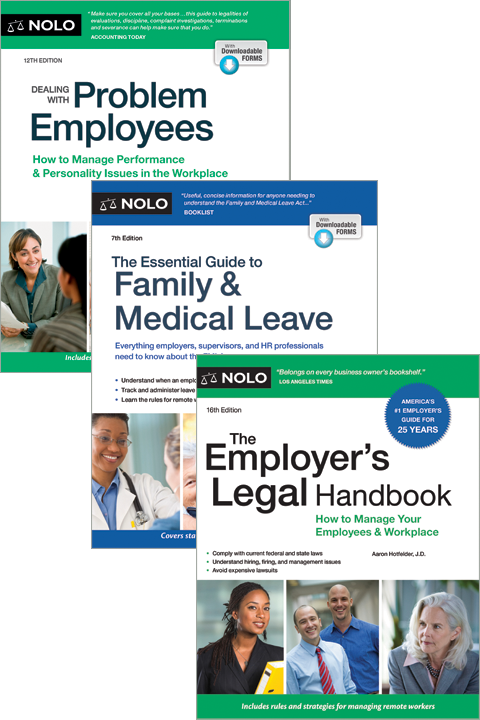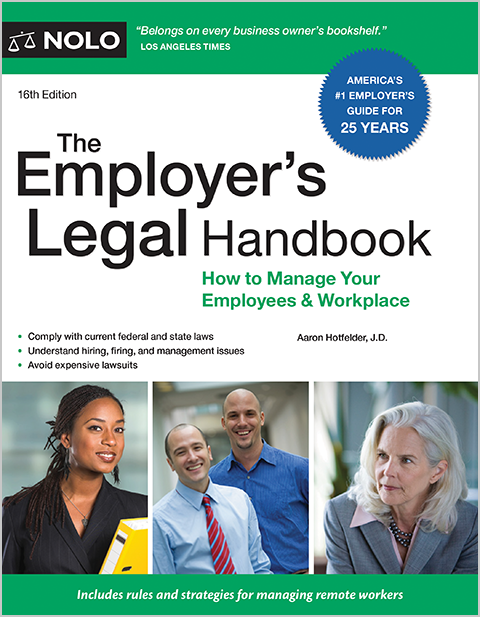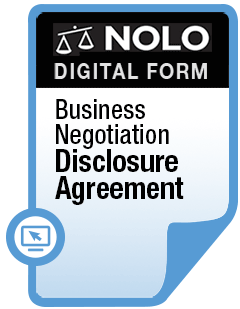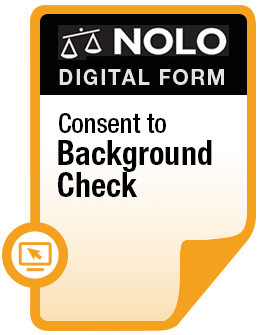Employees may take FMLA leave when a military family member is injured or called to active duty.
The Family and Medical Leave Act (FMLA) provides special rights to employees with family members in the U.S. National Guard, Reserves, and Regular Armed Forces. In particular, the FMLA provides the following two types of military family leave:
- Covered employees may take up to 12 weeks of leave per year to deal with certain issues (called "qualifying exigencies") relating to a family member's active duty or call to active duty.
- Covered employees may take up to 26 weeks of leave in a single year to care for a family member who is seriously ill or injured while on active military duty.
Leave for Active Duty of a Family Member
Employees may take FMLA leave for "any qualifying exigency" arising out of a family member's active duty or call to active duty. This provision joins the existing list of qualifying reasons for which you can take FMLA leave: for your own serious health condition, to care for a seriously ill family member, or to bond with a new child.
You get 12 weeks total. This leave is part of the regular 12-week entitlement available under the FMLA. That is, you get 12 weeks total per year for any qualifying reason, not an additional 12 weeks for issues relating to a family member's military service.
Covered family member. Qualifying exigency leave may be taken only for the employee's spouse, parent, or child who is a member of the military.
What counts as a qualifying exigency. The law specifies eight qualifying exigencies for which an employee may take leave, if necessary due to a military family member's call to active duty:
- Short-notice deployment. The employee may take up to seven calendar days of leave to address issues arising from a family member's call to duty within seven days or fewer of deployment.
- Military events and related activities. The employee may take leave to attend military programs, ceremonies, and events; to attend family support and assistance programs; and so on.
- Child care and school activities. The employee may take time off to arrange care for a family member's child, including providing urgent short-time care, enrolling the child in a new school or day care, and attending meetings with the child's school or day care.
- Financial and legal arrangements. The employee may take time off to help make or update a will, power of attorney, or bank account transfer, for example.
- Counseling. The employee may take leave to attend counseling for himself or herself, the military family member, or the family member's child.
- Rest and recuperation. The employee may take up to fifteen days of leave to spend with a family member who is on short-term, temporary R&R leave during deployment.
- Post-deployment activities. The employee may take time off to attend briefings, ceremonies, and events relating to a family member's return from service, or to address issues arising from the death of a family member on active duty.
- Parental care. The employee may take time off to arrange care for a family member's parent who is incapable of self-care, including providing urgent short-term care, transferring the parent to a care facility, or attending meetings with a care facility.
Employees may also take leave for other activities relating to the family member's active duty if the employer agrees.
Many regular FMLA rules apply. Some of the rules that apply to regular FMLA leave will also apply to leave for a family member's active service. For example:
- This leave may be taken intermittently or on a reduced schedule; you don't have to take all 12 weeks at once.
- Employers may require notice in advance, if the need for leave is foreseeable.
- Employees can substitute, or employers can require them to substitute, applicable accrued paid leave during this type of FMLA leave.
- Employers may require a certification: for example, documentation of the family member's active duty or the family member's Rest and Recuperation leave orders.
Leave to Care for Injured or Ill Service Member
The law also provides a separate leave entitlement for employees who need to care for a seriously ill or injured service member. These employees can take up to 26 weeks of leave in a year for these purposes. Up to 12 of those weeks may be used for any other FMLA qualifying reason. For example, an employee may take three weeks of leave when a family military member is on R&R leave and 23 weeks of military caregiver leave if the military member is seriously injured in the line of duty.
How often can an employee take this leave? This leave provision is a "per injury, per service member" entitlement. In other words, this is a one-time entitlement for a particular family member and a particular injury. The employee may take additional leave in the future only if a different family member is injured while on active duty or the same family member suffers a new injury while on active duty.
Covered service members. A covered service member includes current military members and veterans who have incurred or aggravated a serious illness or injury in the line of active duty. Veterans must have been released from duty under conditions other than dishonorable within the five-year period prior to the employee's first day of leave.
Qualifying family members. Covered family members include not just the spouses, children, and parents covered by the FMLA, but also "next of kin," defined as the service member's nearest blood relative or a blood relative designated by the service member in writing.
Qualifying illness or injury. The illness or injury must stem from active duty and render the service member medically unfit to perform the duties of his or her office, grade, rank, or rating. It includes serious injuries or illnesses sustained while on active duty, as well as the aggravation of a pre-existing injury or illness in the line of active duty. Employees may take leave to care for a family member who is undergoing medical treatment, recuperation, or therapy, is in outpatient status, or is otherwise on the temporary disability retired list for a serious injury or illness resulting from active duty.
Other rules applying to this leave. As is true of most other types of FMLA leave, family members may take this leave on a reduced schedule or intermittently, if that's medically necessary. Employers may require advance notice, if possible, and certification from the service member's health care provider. And the employee may choose—or the employer may require the employee—to use applicable accrued paid leave during this time off.
For more information about these rights, check out the Department of Labor's FMLA materials, at www.dol.gov/whd/fmla/index.htm.
FAQs on Family Military Leave
Who qualifies for family military leave?
To be eligible for family military leave, an employee must work for a covered employer (generally, employers with 50 or more employees within 75 miles); have worked for the employer for at least 12 months; and have worked at least 1,250 hours in the 12 months preceding the start of the leave.
Can you take family military leave intermittently?
Yes, employees are allowed to take intermittent leave, meaning they can take leave in blocks of time or as needed.
What happens if my employer violates FMLA rules on military leave?
Employers who violate the FMLA, whether regarding family military leave or another FMLA provision, may be liable for damages including:
- back pay
- reinstatement
- other compensatory damages
- civil penalties, and
- attorneys' fees.
Do you have to provide documentation to support your request for family military leave under the FMLA?
Employers may choose to require employees to provide documentation to support their request for family military leave, including:
- certification from a healthcare provider regarding the serious health condition of the covered service member, and
- proof of the employee's relationship to the service member.
Employers can also require regular updates from the employee as to their family member's health condition during the period of leave.
Contact an Employment Law Attorney
If your employer refuses to grant your request for family military leave under the FMLA (or your state's equivalent law), your first step should be to alert your employer to your rights under the law.
If that doesn't work, consult an attorney specializing in employment law to discuss your legal options.



